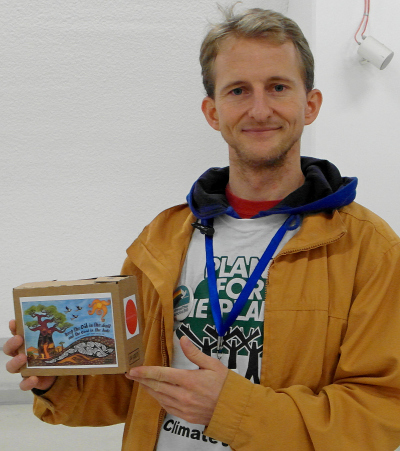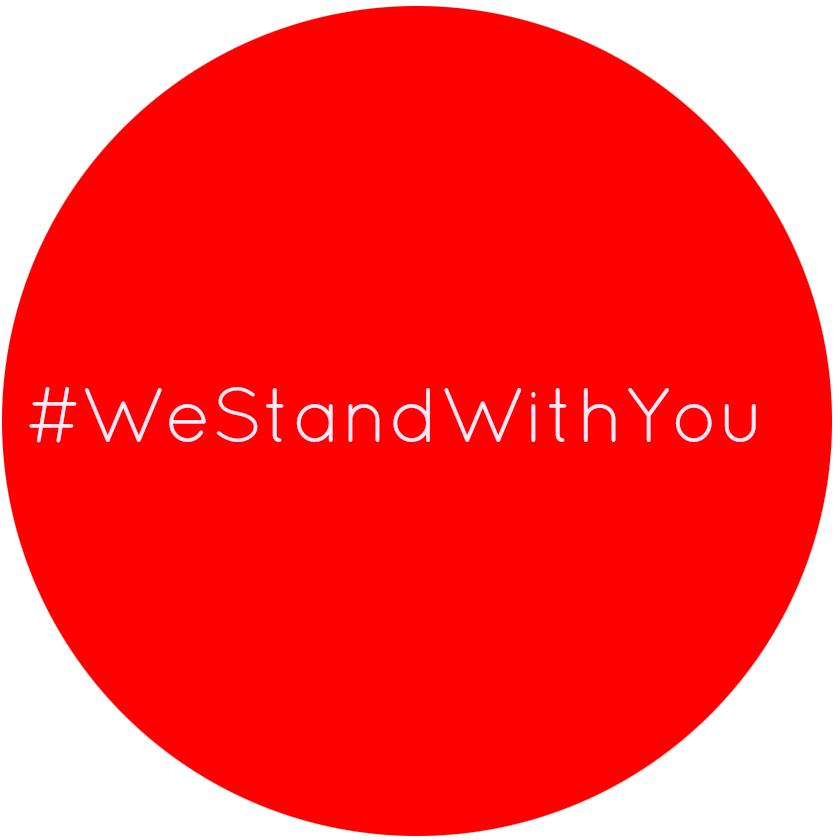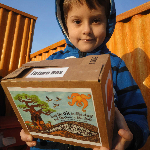Pitch
Put a dollar into the Future Box for each dollar you spend on gas, oil and coal and it will help you leave the fossil age behind in no time!
Description
Summary
The Future Box is a small and simple tool that helps you transition to a sustainable lifestyle at home, and at the same time drive the transition at a society level. Furthermore it helps the victims of climate change.
How does it work?
You put a dollar/euro/peso into a box (your Future Box) for every dollar/euro/peso that you spend on fossil fuels. If you fill your car with gasoline for 40 Euros, 40 Euros go into the box. If you are heating with natural gas and pay your heating bill, the same amount you pay goes into the box. If you take a holiday flight for 1000 USD, another 1000 USD go into the box, effectively bringing this climate-unfriendly way of relaxing to double its former price. In my home, we also pay 100% into our Future Box for supermarket items because of the embedded fossil energy. Local and organic produce or those services that don't use any fossil energy go without a contribution into the box.

When you use a Future Box, your economic reality shifts: climate-unfriendly becomes much more expensive, and climate-friendly is now much cheaper in comparison.
In today's world and with our current heavily fossil fuel-dependent lifestyles, a lot of money accumulates in your Future Box in a short time. What will you do with all this money? Two things. 1. Transition to clean energy. 2. Help the victims of climate change. Both of these are necessary on a personal level, and on a bigger, structural, even global level.
The transition at home is rather straightforward. You can use the money in your box to buy solar panels, insulate your house (to reduce heating or cooling needs), even buy an electric car, switch to renewable energy. At the same time (or after making the bigger investments at home that will take a lot of the money from your box) you can financially support organizations and initiatives that work on structural change.
The other half of the money is for helping the victims of climate change.
Category of the action
Changing public perceptions on climate change
What actions do you propose?
I propose to everyone to use a Future Box as companion on our journey out of the fossil age.
The call is to put the same amount of money that we spend on fossil fuels into the box and use the contents to transition to clean energy and share with the victims of the climate crisis.
The times and places you feed your Future Box are:
- at the gas station, when you buy gasoline,
- when you buy (fossil) fuel for heating your house or pay electricity that is produced by burning fossil fuels,
- when you buy an airplane ticket,
- at the supermarket when you buy food from industrial and/or overseas agriculture,
- anytime you buy products that imply fossil fuel emissions.
Anyone who feels a responsibility to make a contribution to overcoming the climate crisis can use a Future Box. The possibilities of action are as diverse as the contexts of the people using it. In the future, when more people use it, I may work on giving advice on how to spend the money in their Future Boxes. For the moment it should be enough to share some examples from our home to inspire you to come up with your own.
Actions that have come out of our Future Box in our household within 6 months of using it:
- Switching from "conventional" (mainly fossil) to renewable electricity at home.
- An energy audit that showed us the options for improving insulation and switching heating from natural gas to wood. That will be the next step.
- Solar panels on our roof.
- Shifting food buying from 50% supermarket and 10% organic to 50% organic and 10% supermarket (40% other sources remain).
Besides we have supported some initiatives that work for structural change:
- Critical observers at the UN climate talks
- A collective resisting oil extraction in the Ecuadorian Amazon (Yasunidos)
- Activists protecting forests in Southeast Asia
Through the climate change victims "window" of the box, we have supported:
- A basic health care initiative in Kenya
- Victims of a typhoon in the Phillippines
- A basic health care initiative in indigenous communities in Mexico
- Some of the most vulnerable tribal people, through sending letters to decision-makers, asking to respect their rights (A campaign by Survival International)
This is the track record of ONE family using a Future Box for half a year. Imagine thousands of people using Future Boxes all around the world!
A question to be answered by everyone him/herself is how much to put into the Future Box. My simple answer is 100%, the same amount that you feed into the fossil economy. But some people may feel that they cannot afford to pay so much. Here is my guideline as to who can afford what.
Those of us who belong to the "king's class" of people who have been flying on airplanes definitely qualify for paying 100%. Why "king's class"? Because our lifestyle today is more comfortable than that of kings in the old days! If we live like kings, we mustn't destroy anyones livelihood and much less our own children's future. We must stop wrecking the climate as quickly as we can (i.e. transition to clean energy) and we must help those who are suffering the impacts of our kingly lifestyles (i.e. the victims of climate change). If we have enough money to fly on a plane, then we have definitely enough to live up to our responsibility.
Those who have never flown on a plane and subsists on a tight budget are invited to consider what percentage is appropriate for their circumstance. In any case, the Future Box will help with spending less money in the long run, because the expenses of buying fossil fuel (which is sure to rise over the years) will be eliminated from your budget.
My participation in this contest is in order to promote the Future Box and make it known to more people, as well as gather feedback on how to make it even better and compatible with more people. I am sure the interaction with judges, visitors of this website will be helpful to spread the word.
Getting invited to the conference and having more media exposure will surely help, too. So far I have not been able to work on spreading this solution full-time, but maybe an opportunity could arise through these contacts.
Who will take these actions?
There are two levels:
1. Individuals with a Future Box. Naturally those countries where most people are rich have much more potential for well-fed Future Boxes. In poorer countries, there are less people who use big amounts of fossil fuels, middle and upper class. This tools knows no national borders in terms of who should tackle climate change. Everyone who has a rich lifestyle and burns fossil fuels is called to use a Future Box.
2. Those promoting the Future Box. Kjell Kühne originated the concept of the Future Box in October 2013 and has been using it at home and inviting friends to use their own Future Box over the last months.

Feedback has been overwhelmingly positive, but take-up of the Future Box by others has not yet been in correspondence with this positive feedback.
In order to get more people to use Future Boxes, I would like to get support for reaching out to mainstream media and organizations with the potential to multiply the number of people who know about this solution. Celebrities could also play an important role in attracting further followers.
In a second step, those using a Future Box may get organized themselves.
Where will these actions be taken?
Everywhere. Countries with high fossil fuel consumption are going to be more heavily involved. But in today's world, no country is exempt from burning oil, gas and coal, so the attempted reach of the Future Box is necessarily global.
How much will emissions be reduced or sequestered vs. business as usual levels?
100%
The goal for the post-carbon transition is to stop burning fossil fuels and use 100% renewable energy. Currently, most governments are not bold enough to envision a target year for completing this transition. However, led by people who use Future Boxes, I am sure that we will be able to achieve it in the next 3-4 decades.

The emissions reductions in individual cases are substantial. With switching from "brown" to "green" electricity in our home in Germany we went from 11t CO2 to almost nothing. But counting "emissions reduced" is the wrong way to look at the issue. We must ask: "Where am I still using fossils?" and "How do I meet these needs with clean energy?". The Future Box helps stay focused on those questions.
The Future Box is an excellent tool to swiftly reduce fossil energy use. But it doesn't stop there. It is a tool for pioneers of the transition to a post-carbon society. After doing our "homework" we tackle the structural challenges to decarbonize our societies.
What are other key benefits?
The Future Box helps overcome today's dominant mindset of competing against each other. How can you help the victims of climate change (who are not the ones causing the problem) with a competition mindset? Very difficult. The Future Box helps us to keep in mind our responsibility towards the most vulnerable parts of our human family, every day. And it establishes a mechanism where we actively look for opportunities of helping save and improve their lives.

The Red Dot is the symbol of solidarity with the victims of climate change.
What are the proposal’s costs?
Obviously, money is going into the Future Box. But I wouldn't call it "costs", because spending decisions rarely happen in a vacuum where there are no alternatives to spend the same money. I would call it a re-shuffling of priorities. The global priorities of solving the climate crisis and growing together as a human family who care for and look after each other end up with a much higher priority than before. Those priorities that will move down on the list are things that are not critical to our well-being and swallow lots of fossil fuels. Therefore, people who use a Future Box will spend less money on things like consumption or travel.
The interesting thing about the Future Box is that it generates an ever-growing flow of money into the zero carbon economy. The flow of money into the fossil economy gets reduced and diverted into transition activities. And the more you emit, the faster you are able to transition!
For the proposed activities to promote the Future Box, I would like to use the prize money of this competition to reach out to more people. But then, the Future Box must spread horizontally through word of mouth of the people using it.
Time line
In the short term, more and more people will hear and learn about the Future Box and decide to use one. Through media campaigns and celebrities or mass organizations this process can be quickened. Maybe there will be some special forms of communication and organization for people using a Future Box. But the most powerful effect will be on the individuals using the Future Box, because it will help them strengthen their resolve to fight the climate crisis and equip them with resources to get the job done. It will also mean a boost to all those initiatives and organizations who are fighting the necessary and often underfinanced struggle for structural change to post-carbon societies. As mentioned earlier, in the medium term, I expect us to manage the transition to clean energy. Of course the Future Box can only be one ingredient in the mix. But in times of climate crisis, it may become a new cultural standard for global citizens who feel the moral obligation to live up to the responsibility of living a rich, fossil fuel dependent life, while others are less fortunate and future generations are set to suffer.
Related proposals
Tools like iCarbon and Normative can possibly help people with a Future Box to identify products that have a lower carbon footprint. Even though we are not using such sophisticated technology yet, it might be possible to integrate the Future Box contributions into a programme that monitors the emissions content of our purchases.
